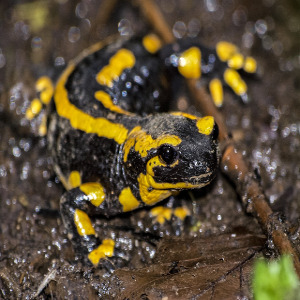10 Symptoms of Diabetes in Dogs
Diabetes can be a challenging condition to manage, especially in pets that cannot verbally communicate how they feel. Recognizing the symptoms of diabetes in...

• Caging: Terrestrial salamanders may be kept in plastic shoeboxes, sweater boxes or in fish tanks. Rubbermaid sweater and shoe boxes work well because they let light in, but are opaque enough to make the salamander feel secure. Holes should be drilled along the sides and on the lid. Salamanders are secretive, and if you use a transparent container such as a fish tank, you will need to provide places for your salamander to hide. You may use clumps of moss or pieces of bark (bake them in the oven first to kill any insects living in them). Ceramic or plastic would be even better, because they do not get moldy. See what you can find in the fish department of your pet store. For a substrate, use damp potting soil. You may mix it with sphagnum moss so it will retain moisture longer. Salamanders must be kept moist, but not wet! Check the soil requently, and mist or add water as necessary. If the salamander looks shriveled, the substrate is too dry.
• Water: Chlorine is toxic to salamanders, so use only distilled water, spring water, or tap water that has been allowed to sit for 24 hours in an open container. A shallow dish of water should be set into the substrate. Many salamanders enjoy soaking in a dish of water, and will defecate there (which makes cleaning easier.)
• Temperature: Salamanders are comfortable in a temperature range of 55-65 degrees F. They can tolerate temperatures up to 80 degrees F. In the summer, move them to a cool spot.
• Food: Salamanders are carnivores. They should be offered as many of the following as possible; earthworms (trout worms for spotted salamanders and night crawlers for tiger salamanders), wax worms, occasionally dusted with reptile vitamins or calcium powder, and live newborn mice. Wax worms and earthworms are now available at Animal City. You can buy a large supply of earthworms at the end of the fishing season and keep
them in your refrigerator. Make sure they stay moist and they will stay alive for a long time. Offer your salamander food every 2-3 days.
• Health: Scoop visible waste deposits of the surface as soon as possible. Every two or three months, redo your salamander cage with fresh soil. Don't use disinfectants; traces of them remaining in the cage could harm your salamander. Wash the cage with warm water and a small amount of mild dish soap. Rinse thoroughly and dry completely to remove any traces of chlorine from the tap water. Then add new soil.
• Cleaning: Handle your salamanders as little as possible. The salt on human skin is harmful to them. Always wet your hand in non-chlorinated water before picking up the salamander. This will prevent injury to the salamander and reduce the amount of salt on your hand. If your salamander should ever appear extremely puffy, it is probably reacting to contact with a toxic substance. Place it in a shallow bowl of chlorine free
water for a few hours to allow it to purify its system.
• To print Salamander care information, click
here.
We are constantly adding new specials to our site. Be sure to check back often!
We currently do not have any events scheduled.

Diabetes can be a challenging condition to manage, especially in pets that cannot verbally communicate how they feel. Recognizing the symptoms of diabetes in...